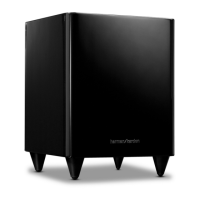
Do you have a question about the Harman Kardon HKTS 200 SUB and is the answer not in the manual?
| Brand | Harman Kardon |
|---|---|
| Model | HKTS 200 SUB |
| Category | Subwoofer |
| Language | English |
Adjusts subwoofer volume. Turn clockwise to increase, counterclockwise to decrease.
Enhances low-frequency performance. Set ON for enhanced bass, OFF for normal performance.
Sets subwoofer phase to match satellite speakers for optimal bass response and sonic impact.
Auto mode turns on with signal; ON mode keeps it powered. LED indicates status.
Connects to trigger voltage source (3-30V AC/DC) for automatic turn-on/off.
Connects to dedicated subwoofer output with low-pass filtering for optimal signal.
Connects to receiver/preamp line outputs when LFE is unavailable or unfiltered.
Turns the subwoofer on or off. Operation depends on Power On Mode setting.
Connect to an active, unswitched electrical outlet. Avoid accessory outlets.
Details operation using Power Switch and Power On Mode for subwoofer activation and standby.
Utilize the Subwoofer Level Control to set the desired listening volume.
Adjust the Phase Switch for optimal bass response and sonic impact with satellite speakers.
Activates enhanced low-frequency performance for more impactful bass during playback.
Check receiver/amplifier status, speaker connections, and wire integrity for no audio output.
Verify balance control, speaker setup, and wiring for issues with a single speaker.
Check center speaker setup, receiver mode, and connections for center channel audio issues.
Verify surround speaker setup, media playback, and connections for surround sound issues.
Check power, level control, and audio connections for no sound output from the subwoofer.
Verify connections, wiring, and impedance match to prevent system shutdown at high volumes.
Connect signal generator, set controls, and verify basic operation, audio response, and LED status.
Use a sweep generator to test cabinet and drivers for rattles, clicks, or buzzes.
Measure woofer DC resistance and listen for rubbing or buzzing during sweep testing.